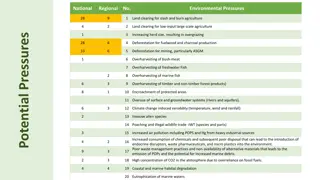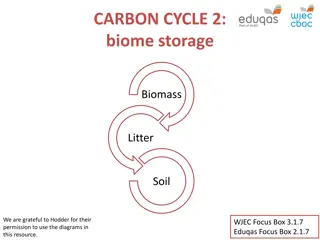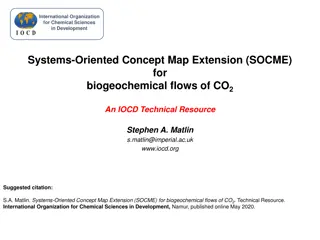Understanding Biomes: Concept, Classification, and Factors
Biomes are large natural ecosystems encompassing plant and animal communities shaped by shared physical climates. They are classified based on climate, vegetation, soil-water, and heat availability, encompassing diverse environments like deserts, forests, savannas, and oceans. The concept of biomes integrates factors to create distinct biological communities across continents. Classification of biomes includes Arctic Tundra, Boreal Forest, Temperate Deciduous Forest, Savanna, Desert, and more, reflecting the relationship between world climates and plant distribution. Understanding these biomes provides insights into global ecosystem diversity and how organisms adapt to varying environmental conditions.
Download Presentation

Please find below an Image/Link to download the presentation.
The content on the website is provided AS IS for your information and personal use only. It may not be sold, licensed, or shared on other websites without obtaining consent from the author. Download presentation by click this link. If you encounter any issues during the download, it is possible that the publisher has removed the file from their server.
E N D
Presentation Transcript
BIOMES: CONCEPT & CLASSIFICATION SEMESTER VI (HONS.) DSE-4 Dr. Sujata Das Deptt. Of Geography Hooghly Women s College
CONCEPT the most extensive ecosystem unit which it is convenient to designate is called Biome the biomes of the world are major world scale regions which integrate a number of factors into an intuitively recognizable whole- deserts, forests, savannas, oceans etc. {I.G. Simmons (1982)} * large natural ecosystem including the total assemblage of plants and animal communities. found over a range of continents * distinct biological communities that have formed in response to a shared physical climate * broader term than habitat * comprises a no. of habitats
CLASSIFICATION # BASED ON CLIMATE & VEGETATION: relationship between the distributional patterns of plants & animals & world climates Biomes of 1st Order (based on Climatic Zones) Biomes of 2ndOrder (based on vegetation) Biomes of 3rdOrder Arctic Tundra Biome TUNDRA BIOME Alpine Tundra Biome Boreal Forest Biome (Taiga Forest Biome) North American Biome TEMPERATE BIOME Asiatic Biome Temperate Deciduous Forest Biome North American Biome European Biome Temperate Grassland Biome Soviet Steppe Biome North American Prairie Biome Pampa Biome Australian Biome Mediterranean Biome Northern Hemispheric Biome Southern Hemispheric Biome Warm Temperate Biome
Biomes of 1stOrder (based on Climatic Zones) Biomes of 2ndOrder (based on vegetation) Biomes of 3rdOrder Tropical Forest Biome Evergreen Rainforest Biome Semi-evergreen Forest Biome Deciduous Forest Biome TROPICAL BIOME Semi-deciduous Forest Biome Montane Forest Biome Swamp Forest Biome Savanna Biome Savanna Forest Biome Savanna Grassland Biome Dry or Arid Desert Biome Semi-arid Biome Desert Biome
BASED ON SOIL-WATER & HEAT AVAILABILITY & GROWTH OF PLANTS Land Biomes are divided on the basis of the availability of soil-water & heat & the growth form of plants OPTIMUM LAND BIOME: Land biomes become optimum biomes which are characterized by the constant supply of soil water & heat throughout the year & the plants grow in all seasons of the year >Tropical Evergreen Rainforest Biome BIOMES WITH SEASONAL CLIMATES: There are atleast 2 seasons in a year with marked variations in temperature & humidity > Monsoon Forest Biome > Temperate Deciduous Forest Biome > Coniferous Forest Biome > Mediterranean Forest Biome > Savanna Biome > Tall grass Prairie Biome > Short grass Steppe Biome BIOMES WITH PERMANENT DEFICIENCY IN HEAT AND OR WATER > Semi arid Biome > Warm Arid Biome > Temperate Arid Biome > Arctic Tundra Biome > Alpine Mountainous Tundra Biome
AQUATIC BIOME TYPES Continental Shelf Biome Warm Water Biome Open Sea Biome Upwelling Waters Biome Cold Water Biome Continental Shelf Biome Open Ocean Biome River Biome Freshwater Biome Lake Biome Pond Biome Ref: S. Singh Environmental Geography























